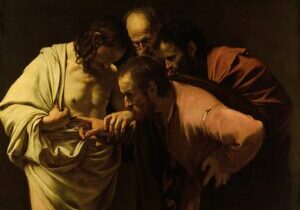That You May Have Life in His Name
 The Gospel According to John concludes with the statement that “Jesus did many other signs in the presence of his disciples that are not written in this book.” The signs that have been included were selected to help others believe “that Jesus is the Christ, the Son of God” and as a result have “life in his name.” There is an Appendix that was added at some point after these final words from the twentieth chapter, but most scholars agree that the Appendix was written by someone else.
The Gospel According to John concludes with the statement that “Jesus did many other signs in the presence of his disciples that are not written in this book.” The signs that have been included were selected to help others believe “that Jesus is the Christ, the Son of God” and as a result have “life in his name.” There is an Appendix that was added at some point after these final words from the twentieth chapter, but most scholars agree that the Appendix was written by someone else.
John divided his account of the Good News of Jesus’ life into two sections: The Book of Signs and The Book of Glory. The Gospel opens with the famous Prologue, “In the beginning was the Word.” The book of Genesis begins with the same phrase, “In the beginning.”
The Book of Signs starts with Jesus’ baptism at the Jordan River and concludes with his triumphal entry into Jerusalem on Palm Sunday. The Book of Glory begins with the washing of the feet of his disciples and a long teaching on love and trust in God at the Last Supper. It continues through his passion, death, resurrection, and appearances to his friends, including Mary Magdalene in the garden.
The story of Jesus’ appearance to his friends in the locked room on Easter Sunday night and his return visit a week later when Thomas was present as well, are the final stories of the Book of Glory. (Jn 20:19-31) In these two stories, Jesus appears among his friends without warning or notice of any kind. He is simply and suddenly there with them. His first word to them each time is the greeting, “Peace be with you.” This peace is a deeply existential peace. No matter what happens, this peace will remain. It is a peace that is lived. It is a peace that brings healing and forgiveness – a peace that leads to community and life. His words to Thomas sum up nicely Jesus’ love for all those who would never meet him in person but who would become his followers through the centuries: “Blest are they who have not seen and have believed.” The Resurrection peace of Christ extends to each of us as well.
On the Feast of Pentecost, the Holy Spirit blew into the lives of the disciples in a very special way. They stopped being afraid and hiding from the authorities. Instead, they stepped into the public eye and began to witness boldly to their experience of Jesus’ coming and his resurrection. Many people believed their witness and began to gather together to live as a community. St. Luke describes their lives in the first part of the Acts of the Apostles. They shared what they had, cared for those who had little, gathered to pray at the Temple, broke bread in their homes as Jesus had instructed them to do, and shared their meals together. The community grew rapidly and shared a sense that they had been saved and given new life through the teaching and sacrifice of Jesus. The resurrection changed everything. New life was theirs. (Acts 2:42-47)
As the community grew and spread into other areas, the sense of new birth and a living hope through Jesus’ resurrection became a characteristic of its members. The letter of St. Peter (1 Pt 1:3-9) reminds those who believe in Jesus that an imperishable inheritance is waiting for those who remain faithful. Through their trust and perseverance in loving Christ, they will reach their goal, the “salvation of your souls.” The teachings of those who were witnesses to the actions and teachings of Jesus have led those who were not present to share the same faith with those who were. And all will have “life in his name.”
It has been one week since we began our celebration of the Resurrection. Will Jesus be present in our homes at the end of this day? Where and how will we see him? How will we offer forgiveness to each other for times we have been hurt? How will we seek forgiveness for the times we have hurt others? And as loved and forgiven sisters and brothers of Jesus, where is the Lord sending us? To whom will we bring the good news of God’s love?
Readings for the Second Sunday of Easter










